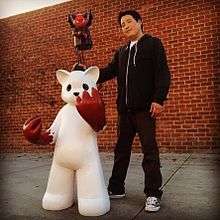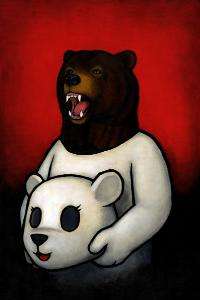Luke Chueh
Luke Chueh (/ˈtʃuː/; born March 7, 1973) is a Chinese-American lowbrow, or pop surrealist, painter. His works tends to be a juxtaposition of the cute with the macabre, including various self-portraits reimagining himself as a bear character.
Luke Chueh | |
|---|---|
 Luke Chueh with his 4ft Possessed sculpture (2014) | |
| Born | March 7, 1973 |
| Nationality | American |
| Alma mater | California Polytechnic State University |
| Occupation | Artist |
| Years active | 2003–present |
| Known for | Painting, drawing, graphic design, sculpture |
Notable work |
|
| Home town | Fresno, California, United States |
| Movement | Lowbrow, designer toy |
| Website | lukechueh |
| Signature | |
Born to Chinese immigrants in Philadelphia, Pennsylvania, Chueh's family relocated to Fresno, California soon after his birth. Taught illustration at a young age, he became obsessed with interpreting the popular culture imagery he was surrounded by. Trained as graphic designer at California Polytechnic State University in San Luis Obispo, he was hired as an in-house designer & illustrator at the Ernie Ball Company in 1997. His work during this time garnered him several awards as well as features in the 1998 design annuals of both Communication Arts and Print. Developing an addiction to painkillers, Chueh was fired from his job and relocated to Los Angeles without any prospects. He continues to create artwork in Los Angeles with regular updates on Facebook and Instagram. Chueh has been sober since 2010.
Life
Early years
Luke Chueh was born on March 3, 1973,[1] and he is a first generation Chinese-American, both of his parents having immigrated to the United States from China.[2] When he was three months old, Chueh's family relocated from his birthplace of Philadelphia, Pennsylvania to Fresno, California.[3] At the age of four, his mother taught him how to draw Mickey Mouse, which began a childhood obsession to paint and illustrate renditions of his favorite things, mainly Star Wars and other "science fiction stuff that I was watching all the time."[2]
After graduating from Clovis West High School in 1991,[4] the 18-year-old enrolled into the Art & Design program at California Polytechnic State University in San Luis Obispo.[3] Nearing the completion of his degree, one his professors confided in Chueh that he was "a mediocre graphic designer," but explained that he was "a great illustrator" and "should pursue a career in that",[2] despite the fact that Chueh had a graphic design concentration and his "formal" art training was restricted to a "couple quarters of Life Drawing and Illustrations classes".[3]
Hired by the Ernie Ball Company as an in-house designer & illustrator before receiving his bachelor's degree in 1997,[5][6] Chueh primarily created T-shirt and advertisement designs for the brand.[2] Several of these became award-winning,[5] with the artist himself being featured in the 1998 design annuals of both Communication Arts and Print.[7] During this time, Chueh began spending his nights partying, drinking, and doing drugs.[2] In 2003,[3] an addiction to painkillers resulted in his being fired, which spurred Chueh's relocation to Los Angeles with no job prospects.[2][5]
Emerging artist
Artistic breakthrough
Style & works
Artistic development

His images have been remarked upon for their juxtaposition of cuteness with the macabre.[8] "Traditionally, the sublime is described as the beautiful tinged with pain," said Steppling gallery director Sheila Dollente. "Chueh pares that idea to a single spare image borne by figures reminiscent of the soft, innocent stuffed animals of childhood. His paintings are at once intriguing, puzzling, friendly and sorrowful."[9] His paintings and illustrations are noted for bringing together influences as diverse as Mark Rothko and Sanrio.[10][11] Chueh draws inspiration from deeply personal experiences to popular culture, and has created works that stem from the intolerance he suffered as a child growing up as a Chinese-American.[12]
In an interview with Art Prostitute Magazine he stated that he is influenced by his contemporaries utilizing strong illustrative elements. He mentioned Chiho Aoshima, Marcel Dzama, Jeremy Fish, Gary Baseman, Camille Rose Garcia, Barry McGee, Takashi Murakami, Yoshitomo Nara, Mark Ryden, and Ralph Steadman.[13]
In his recent work, he has designed the album artwork for Fall Out Boy's album Folie à Deux (2008).[7]
Major series
References
Citations
Sources
- Chueh, Luke (n.d.). "Biography". LukeChueh.com. Los Angeles, CA. Archived from the original on February 19, 2017. Retrieved February 28, 2017.
- Chueh, Luke (n.d.). "Lucas Chucas: Facebook". Facebook.com. Menlo Park, CA. Archived from the original on March 1, 2017. Retrieved March 1, 2017Luke Chueh's personal Facebook page under the alias Lucas Chucas
- Chueh, Luke (n.d.). "Luke Chueh: LinkedIn". LinkedIn.com. Mountain View, CA. Retrieved March 1, 2017.
- Curtis, Nick; Ralat, Pamela, eds. (n.d.). "Artist Archive: Luke Chueh". CoART Magazine. Beacon, NY. Archived from the original on March 1, 2017. Retrieved February 28, 2017.
- Gibbs, Gregg (March 2017). Pricco, Evan (ed.). "Luke Chueh: The Unbearable Heaviness of Being". Juxtapoz Magazine. No. 194. Portrait by Lucas Celler. San Francisco, CA: High Speed Productions, Inc. pp. 98–105. OCLC 889970639. Archived from the original on February 6, 2017. Retrieved February 28, 2017.CS1 maint: ref=harv (link)
- Grierson, Tim (April 26, 2004). "Kids These Days". The Simon. Los Angeles, CA. Archived from the original on June 8, 2004. Retrieved November 1, 2008.CS1 maint: ref=harv (link)
- Leach, Matt (November 2004). "Cute But Sad". Empty Magazine. No. 2. Australia. Archived from the original on December 30, 2004. Retrieved November 1, 2008.CS1 maint: ref=harv (link)
- "Luke Chueh exhibit featured at SDSU-IV art gallery". Imperial Valley Press. El Centro, CA. November 4, 2003. Archived from the original on June 12, 2004. Retrieved November 1, 2008.
- Milosevic, Nikola (n.d.). "Biography: Luke Chueh". WideWalls. Switzerland. Archived from the original on February 18, 2017. Retrieved March 1, 2017.
- Searcy, Mark; Gibb, Brian, eds. (August 2005). "Featurette". Art Prostitute. No. 6. Texas. Archived from the original on March 27, 2006. Retrieved November 1, 2008.
- Spoor, Nathan (2012) [First published in Hi-Fructose Magazine, Volume 12 (July 2009), pp. 42-45]. "Ring of Fire: An Interview with Luke Chueh". In Owens, Annie; Attaboy (eds.). Hi-Fructose: Collected Edition, Volume 3. San Francisco, CA: Last Gasp. pp. 246–251. ISBN 978-0-86719-771-6. Archived from the original on March 1, 2017. Retrieved March 1, 2008.CS1 maint: ref=harv (link)
- Taylor, Mia (2004). "Bright ideas from the hole in his soul". The Book LA. Vol. 1. Los Angeles, CA. Archived from the original on June 12, 2004. Retrieved November 1, 2008.CS1 maint: ref=harv (link)
- Whitehouse, Geoff (Fall 2007). "The Colour & The Shape". Clutter. No. 11. UK. ASIN B00C29EYEK. Archived from the original on November 19, 2007. Retrieved November 1, 2008.CS1 maint: ref=harv (link)